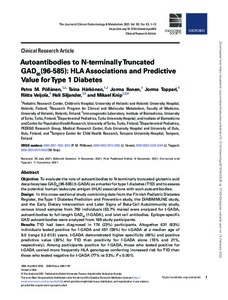Autoantibodies to N-Terminally Truncated GAD65(96-585): HLA Associations and Predictive Value for Type 1 Diabetes
Pöllänen Petra M; Härkönen Taina; Ilonen Jorma; Toppari Jorma; Veijola Riitta; Siljander Heli; Knip Mikael
https://urn.fi/URN:NBN:fi-fe2022021519182
Tiivistelmä
Objective
To evaluate the role of autoantibodies to N-terminally truncated glutamic acid decarboxylase GAD65(96-585) (t-GADA) as a marker for type 1 diabetes (T1D) and to assess the potential HLA-associations with such autoantibodies.
Design
In this cross-sectional study combining data from the Finnish Pediatric Diabetes Register, the Type 1 Diabetes Prediction and Prevention (DIPP) Study, the DIABIMMUNE Study, and the Early Dietary Intervention and Later Signs of Beta-Cell Autoimmunity (EDIA) Study, venous blood samples from 760 individuals (53.7% males) were analyzed for t-GADA, autoantibodies to full-length GAD65 (f-GADA), and islet cell antibodies. Epitope-specific GAD autoantibodies were analyzed from 189 study participants.
Results
T1D had been diagnosed in 174 (23%) participants. Altogether 631 (83%) individuals tested positive for f-GADA and 451 (59%) for t-GADA at a median age of 9.0 years (range 0.2-61.5). t-GADA demonstrated higher specificity (46%) and positive predictive value (30%) for T1D than positivity for f-GADA alone (15% and 21%, respectively). Among participants positive for f-GADA, those who tested positive for t-GADA carried more frequently HLA genotypes conferring increased risk for T1D than those who tested negative for t-GADA (77 vs. 53%; P<0.001).
Conclusions
Autoantibodies to N-terminally truncated GAD improve the screening for T1D compared to f-GADA and may facilitate the selection of participants for clinical trials. HLA class II-mediated antigen presentation of GAD(96-585)-derived or structurally similar peptides might comprise an important pathomechanism in T1D.
Kokoelmat
- Rinnakkaistallenteet [27094]
